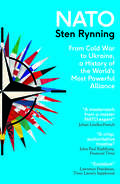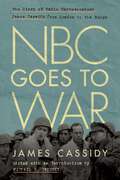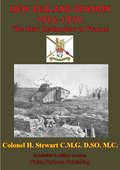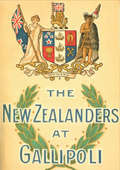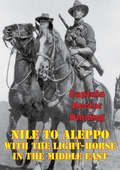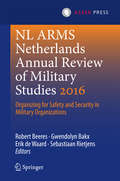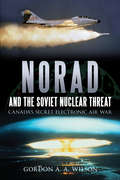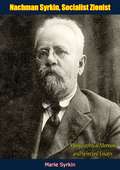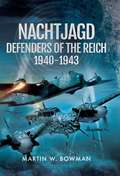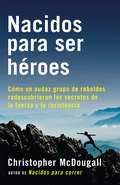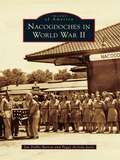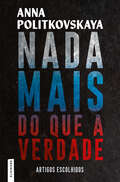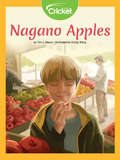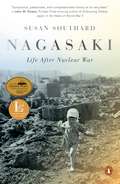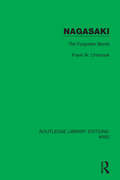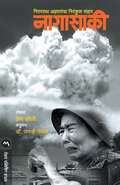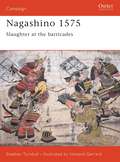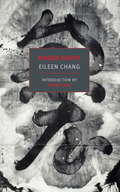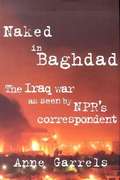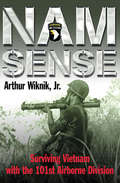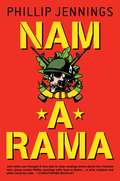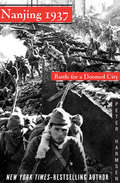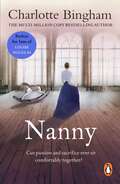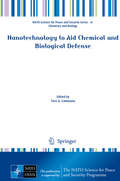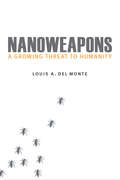- Table View
- List View
NATO: From Cold War to Ukraine, a History of the World's Most Powerful Alliance
by Sten RynningA wide-ranging new history of NATO, from its origins to the present day—published for the alliance’s seventy-fifth anniversary For seven decades, NATO’s stated aim has been the achievement of world peace—but playing great power politics always involves conflict. Russia’s war on Ukraine and on Europe’s security order puts the alliance under threat, but also demonstrates why transatlantic cooperation is so necessary. But how did NATO get to where it is today, and what does its future hold? In this incisive new account, Sten Rynning traces the full history of the North Atlantic Treaty Organisation from its origins to the present. Across its seventy-five years, NATO has navigated the twists and turns of Cold War diplomacy and nuclear deterrence, and has grown its membership. The alliance has become a guarantor of peace, but Rynning explores how its complex inner workings alongside Russian and Chinese opposition are now shaping its direction. At a time of strategic competition and geopolitical upheaval, Rynning offers us a clear-sighted account of the alliance’s intriguing history—and asks what its ambitions might be for the future.
NBC Goes to War: The Diary of Radio Correspondent James Cassidy from London to the Bulge (World War II: The Global, Human, and Ethical Dimension)
by James CassidyThe diary of radio correspondent James Cassidy presents a unique view of World War II as this reporter followed the Allied armies into Nazi Germany.James Joseph Cassidy was one of 362 American journalists accredited to cover the European Theater of Operations between June 7, 1944, and the war’s end. Radio was relatively new, and World War II was its first war. Among the difficulties facing historians examining radio reporters during that period is that many potential primary documents—their live broadcasts—were not recorded. In NBC Goes to War, Cassidy’s censored scripts alongside his personal diary capture a front-line view during some of the nastiest fighting in World War II as told by a seasoned NBC reporter.James Cassidy was ambitious and young, and his coverage of World War II for the NBC radio network notched some notable firsts, including being the first to broadcast live from German soil and arranging the broadcast of a live Jewish religious service from inside Nazi Germany while incoming mortar and artillery shells fell 200 yards away. His diary describes how he gathered news, how it was censored, and how it was sent from the battle zone to the United States. As radio had no pictures, reporters quickly developed a descriptive visual style to augment dry facts. All of Cassidy’s stories, from the panic he felt while being targeted by German planes to his shock at the deaths of colleagues, he told with grace and a reporter’s lean and engaging prose.Providing valuable eyewitness material not previously available to historians, NBC Goes to War tells a “bottom-up” narrative that provides insight into war as fought and chronicled by ordinary men and women. Cassidy skillfully placed listeners alongside him in the ruins of Aachen, on icy back roads crawling with spies, and in a Belgian bar where a little girl wailed “Les Américains partent!” when Allied troops retreated to safety, leaving the town open to German re-occupation. With a journalistic eye for detail, NBC Goes to War unforgettably portrays life in the press corps. This newly uncovered perspective also helps balance the CBS-heavy radio scholarship about the war, which has always focused heavily on Edward R. Murrow and his “Murrow’s Boys.”
NEW ZEALAND DIVISION 1916-1919. The New Zealanders In France [Illustrated Edition] (Official History Of New Zealand’s Effort In The Great War #2)
by Colonel H Stewart C.M.G. D.S.O. M.C.Contains over 100 maps, photos and illustrations"Formed in Egypt in March 1916 the division arrived in France a month later. It acquired an elite status, fought on the Somme, at Messines and Third Ypres. 49,000 casualties, ten VCs. A very fine and comprehensive history....As may be expected this is a remarkably comprehensive account of one of the finest divisions of the BEF of which Earl Haig wrote: "No Division in France built up for itself a finer reputation, whether for the gallantry of its conduct in battle or for the excellence of its behaviour out of the line. Its record does honour to the land from which it came and to the Empire for which it fought." A German assessment of the division was seen in an Intelligence document captured at Hebuterne in July 1918:- "A particularly good assault Division. Its characteristics are a very strongly developed individual self-confidence or enterprise, characteristic of the colonial British, and a specially pronounced hatred of the Germans."...The NZ Division of this history was formed in Egypt in March 1916...The infantry consisted of two battalions each of the Auckland, Canterbury, Otago and Wellington Regiments and four battalions of the NZ Rifle Brigade, all the divisional troops-artillery, engineers, medical etc .were NZ units. The GOC was Major-General Sir A.H. Russell, promoted from command of a brigade of the composite NZ and Australian Division; he was to be the only commander of the division. The NZ Division arrived in France in April 1916 and it remained on the Western front throughout the war....The author commanded the 2nd Battalion Canterbury Regiment and in preparing this official account he has drawn on all available material - War Diaries, Operation Orders, Intelligence summaries, Narratives of operations prepared at Corps level and below, Honours and Awards recommendations, Divisional reports and correspondence, personal diaries and papers and Haig's Despatches. ..."--N&M Print Ed
NEW ZEALANDERS AT GALLIPOLI [Illustrated Edition] (Official History Of New Zealand’s Effort In The Great War #1)
by Major Fred Waite D.S.O.Contains over 55 photos and 10 maps."Someone once remarked that the 'NZ' in ANZAC is silent, and perhaps people associate ANZAC especially with Australia with its ANZAC Day parade and commemorative services. This book, part of the Official History of New Zealand's effort in the Great War, clearly shows the extent of New Zealand's part in that ill-fated Gallipoli campaign. The NZEF sailed from Wellington on 16th October 1914, in all 351 officers and 7410 other ranks making four infantry battalions, four mounted rifles regiments, an artillery brigade, sappers, signals, medical and other divisional troops. They disembarked in Alexandria on 3rd December and the infantry battalions were attached to the Canal defence force where, in February 1915 they had their first brush with the Turks, repelling an attack on the Canal. In Egypt they combined with Australian troops to form the New Zealand and Australian Division, landing on Gallipoli on 25th April 1915. By the end of the campaign they had suffered 7,197 battle casualties (Medical History of the War ) or almost one hundred per cent of the original expeditionary force. [It] gives a clear picture of the terrain over which the battles were fought, the climate, the conditions, the intensity of the fighting and a realistic account of the horrors of the battlefield. The easy-to-read text is supported by a wealth of contemporary photos and clear maps. There is a list of honours ... (one VC) including Mention in Despatches .... The appendices also contain tables showing ships transporting the NZEF and which units each carried; the ships carrying the division to Gallipoli; the detailed strengths, by units, of the original expeditionary force and subsequent units raised during the Gallipoli campaign. There is a very useful glossary of all the place names mentioned in the text with translation of some of the Turkish features e.g., Tepe, a hill; Kale, a fort; and there is a Gallipoli Diary." --N&M Print Ed.
NILE TO ALEPPO: With The Light-Horse In The Middle East [Illustrated Edition]
by Major Hector William DinningIncludes World War One In The Desert Illustration Pack- 115 photos/illustrations and 19 maps spanning the Desert campaigns 1914-1918"Fresh and vivid memoir of an Australian horseman serving in the Palestine campaign. Includes a chapter 'Working with Lawrence' on the legendary T.E. Lawrence of Arabia.The author, Brisbane-born Captain Hector Dinning, was an officer in the "Light Horsemen" of the Australian Army in the Great War. He served with his unit in the Palestine campaign, journeying from Cairo in Egypt to Aleppo in Syria, and recounts his experiences in the Middle East. This book will especially interest anyone keen on T.E.. Lawrence 'of Arabia'. Dinning worked alongside the legendary Colonel and his portrait of him is especially valuable as it was written early (1920) before the legend of Lawrence had taken hold. Written in a direct, forceful and typically Australian style, this memoir will delight anyone interested in Lawrence, the Middle East and the Great War."-Print Edition
NL ARMS Netherlands Annual Review of Military Studies 2016
by Robert Beeres Gwendolyn Bakx Erik De Waard Sebastiaan RietjensNL ARMS 2016 offers a collection of studies on the interrelatedness of safety and security in military organizations so as to anticipate or even prepare for dire situations. The volume contains a wide spectrum of contributions on organizing for safety and security in a military context that are theoretically as well as empirically relevant. Theoretically, the contributions draw upon international security studies, safety science and organizational studies. Empirically, case studies address the reality of safety and security in national crisis management, logistics and unconventional warfare, focusing, amongst others, on rule of law during missions in which expeditionary military forces are involved in policing tasks to restore and reinforce safety and security and on the impact of rule of law on societal security. The result is a truly unique volume that may serve practitioners, policymakers and academics in gaining a better understanding of organizing for the security-safety nexus.
NORAD and the Soviet Nuclear Threat: Canada’s Secret Electronic Air War
by Gordon A.A. WilsonExplore the history of the Canadian air defence of North America during the Cold War. NORAD and the Soviet Nuclear Threat is the history of the air defence of Canada during the Cold War era. The reader is taken into the Top Secret world of NORAD, the joint Canadian-American North American Air Defence network. Ride along with the aircrew in their cockpit as they fight an electronic joust in the skies. Go deep underground to the Command Centre as the Air Weapons controllers plot the air war on their radar screens. Visit the radar sites deep in the Canadian bush as they struggle to provide the radar data for an electronic air battle happening overhead.An actual NORAD exercise on 10 May 1973, called Amalgam Mute, is used as an example. This exercise tested that NORAD was honouring its motto: Deter, Detect, Destroy, and was protecting North America from aerial threat. There is an extensive explanation of the aircraft, squadrons, weapons, radar, and radar sites involved.Included are two personal accounts of the first interception of a Soviet "Bear" bomber off the coast of Canada, and the first Canadian fighter interceptor pilot to win the coveted United States Air Force "Top Gun" award.
Nachman Syrkin, Socialist Zionist: A Biographical Memoir and Selected Essays
by Marie Syrkin Nachman SyrkinNachman Syrkin (1868-1924) was a political theorist, founder of Labour Zionism and a prolific writer in the Hebrew, Yiddish, Russian, German and English languages.In this present volume, which was first published in 1961, his daughter Marie Syrkin reprints translations of some of his more influential essays, and remembers her childhood and youth and the wanderings of her family over the face of the earth at a time not only of danger and suffering, but of adventure and romance and real enjoyment.A lively, engaging read!
Nachtjagd: Defenders of the Reich, 1940–1943 (The\second World War By Night Ser.)
by Martin W. BowmanThis new volume from Martin Bowman examines the first three years of the Second World War, consolidating first-hand accounts from German fighter pilots caught up in some of the most dramatic night time conflicts of the early war years.Viewing Bomber Command's operations through the eyes of the enemy, the reader is offered a fresh and intriguing perspective. Set in context by Bowman's historical narrative, these snippets of pilot testimony work to offer an authentic sense of events as they played out.
Nacidos para ser héroes: Cómo un audaz grupo de rebeldes redescubrieron los secretos de la fuerza y la resistencia (A Vintage Español Original)
by Christopher McdougallTras el ultramaratón por las Barrancas del Cobre narrado en el bestseller Nacidos para correr, Christopher McDougall encuentra su siguiente aventura en las escarpadas montañas de Creta, donde un grupo de guerrilleros de la Resistencia planearon el secuestro de un general nazi durante la Segunda Guerra Mundial. ¿Cómo es que un artista arruinado, un joven pastor y un poeta bohemio lograron esconder a un general alemán de miles de soldados nazis solo con su ingenio y su valentía?McDougall viaja hasta la isla para seguir sus pasos y encontrar la respuesta, para experimentar de primera mano los extraordinarios retos físicos que tuvieron que afrontar los combatientes de la Resistencia y sus aliados locales. En Creta, la cuna de héroes clásicos como Hércules o Ulises, McDougall descubre cuáles son las habilidades del héroe: movimientos naturales, una resistencia extraordinaria y una nutrición eficiente.Nacidos para ser héroes es una investigación fascinante sobre la fuerza y la capacidad de superación del cuerpo humano, que nos lleva desde las calles de Londres a medianoche hasta el amanecer en las playas de Brasil, desde las montañas de Colorado al patio de McDougall en Pennsylvania, lugares donde atletas modernos perfeccionan técnicas antiguas para ser capaces de todo. Del mismo modo que Nacidos para correr animó a miles de lectores a dejar la cinta, quitarse las zapatillas y salir a la naturaleza, Nacidos para ser héroes les motivará para dejar el gimnasio y hacer sus ejercicios al aire libre: trepar, nadar, saltar y emprender sus propias hazañas.
Nacogdoches in World War II (Images of America)
by Peggy Arriola Jasso Jan Dobbs BartonNacogdoches, the oldest town in Texas, has a long and colorful history starting in 1716, when the first mission, Nuestra Señora de Guadalupe de los Nacogdoches, was founded. The people of this rich area have since come together countless times to survive challenges. During World War II, patriotism brought everyone closer as the young men of the area left to fight for their country. College enrollment declined drastically until a masterstroke by its president brought the nation's first WAC school to the campus. An unexpected ice storm killed valuable timber, bringing Nazi POWs to the area to harvest the pine trees. On the home front, everyone got involved in the war effort. They knitted, rolled bandages, collected scrap metal, bought war bonds, grew victory gardens, and participated in rationing and blackouts; but most of all they sacrificed their sons. They came together during those years and still come together today to celebrate the historic town's past and to honor its veterans of all wars.
Nada Mais do que a Verdade: Artigos Escolhidos
by Anna PolitkóvskayaUm livro atual e inspirador: a recolha definitiva dos melhores artigos escritos por Anna Politovskaya. «O que importa é a informação, não o que se pensa sobre ela.» Foi este o lema que norteou o corajoso e clarividente trabalho jornalístico de Anna Politkovskaya na Novaya Gazeta, numa era em que, segundo a própria, a liberdade de expressão na Rússia se encontraem fase terminal e o medo na sociedade esteriliza qualquer forma de idealismo. Descrevendo a vida tal como a via, relatando factos e testemunhos denunciadores de uma desumanidade sistémica, Politkovskaya ajudou a compreender a paisagem da Rússia pós-soviética, a corrupção na Pirâmide do Poder de Putin e a guerra na Chechénia. Admirada por notáveis do mundo da cultura e da política e agraciada com inúmeros prémios internacionais, foi, contudo, considerada uma pária pelo Kremlin e perseguida por aqueles que a viam como perigosa opositora, até ao seu assassínio em 2006. Publicado postumamente, Nada Mais do Que a Verdade é a recolha fundamental e definitiva num único volume dos melhores artigos de Anna Politkovskaya, incluindo textos inéditos recuperados do seu computador pessoal. Um livro atual e esclarecedor, e uma homenagem a uma das figuras mais célebres e inspiradoras do jornalismo internacional. «Uma compilação cujos estilo e efeito são reminiscentes de O Arquipélago Gulag, de Aleksandr Soljenítsin.» The Independent «Anna Politkovskaya recusou-se a mentir; o seu assassínio foi um ataque perpetrado contra a literatura mundial.» Nadine Gordimer «Uma jornalista heroica.» The Guardian «Continuaremos a lê-la e a aprender com ela durante muitos anos.» Salman Rushdie «A sua morte constitui um grave crime contra o país, contra todos nós.» Mikhail Gorbachev
Nagano Apples
by Tim J. MyersDavid and his father are on their way home from Hiroshima in Japan. During the drive home, they stop at an apple farm where an old man tells David about his time as a soldier in World War II. The story helps David understand that kindness can happen even in the darkest of times.
Nagasaki: Life After Nuclear War
by Susan SouthardWINNER of the J. Anthony Lukas Book Prize and the Dayton Literary Peace PrizeFINALIST for the Ridenhour Book Prize • Chautauqua Prize • William Saroyan International Prize for Writing • PEN Center USA Literary Award NAMED ONE OF THE BEST BOOKS OF THE YEAR BYThe Economist • The Washington Post • American Library Association • Kirkus Reviews“A poignant and complex picture of the second atomic bomb’s enduring physical and psychological tolls. Eyewitness accounts are visceral and haunting. . . . But the book’s biggest achievement is its treatment of the aftershocks in the decades since 1945.” —The New YorkerA powerful and unflinching account of the enduring impact of nuclear war, told through the stories of those who survived. On August 9, 1945, three days after the atomic bombing of Hiroshima, the United States dropped a second atomic bomb on Nagasaki, a small port city on Japan’s southernmost island. An estimated 74,000 people died within the first five months, and another 75,000 were injured.Published on the seventieth anniversary of the bombing, Nagasaki takes readers from the morning of the bombing to the city today, telling the first-hand experiences of five survivors, all of whom were teenagers at the time of the devastation. Susan Southard has spent years interviewing hibakusha (“bomb-affected people”) and researching the physical, emotional, and social challenges of post-atomic life. She weaves together dramatic eyewitness accounts with searing analysis of the policies of censorship and denial that colored much of what was reported about the bombing both in the United States and Japan. A gripping narrative of human resilience, Nagasaki will help shape public discussion and debate over one of the most controversial wartime acts in history.From the Hardcover edition.
Nagasaki: The Forgotten Bomb (Routledge Library Editions: WW2 #20)
by Frank W. ChinnockThis book, first published in 1970, examines the atomic bombing of Nagasaki, when an entire industrial city was devastated and the bulk of its population killed or wounded. Coming days after the bombing of Hiroshima, Nagasaki has largely been forgotten. This book traces the decision by the US to use the second bomb, and the choice of Nagasaki as its target. It follows the bomber to the skies over Nagasaki, and the terrible events that unfolded. Using diaries, written accounts and the testimonies of hundreds of Japanese civilians who survived the bombing, this book provides the definitive text on the Nagasaki atomic bomb.
Nagasaki: नागासाकी
by Craig Collie‘नागासाकी’ ही कादंबरी म्हणजे १९४५ मध्ये अमेरिकेने जपानच्या हिरोशिमा आणि नागासाकीवर अणुबॉम्ब टाकला, त्याच्या पार्श्वभूमीची, परिणामांची आणि त्या अनुषंगाने येणाऱ्या अनेक बाबींची विस्तृत कहाणी आहे. १६ ते २९ जुलै आणि ५ ऑगस्ट १९४५ ते १० ऑगस्ट १९४५ या दिवसांतील राजकीय घडामोडींचं आणि हिरोशिमा, नागासाकीतील लोकांच्या दैनंदिन जीवनाचं चित्रण, असं सर्वसाधारणपणे या कादंबरीचं स्वरूप आहे. क्रेग कोली यांनी संशोधन करून, खूप संदर्भ अभ्यासून, प्रत्यक्षदर्शींच्या मुलाखती घेऊन ही कादंबरी सिद्ध केली आहे. जपानने पर्ल हार्बरवर केलेल्या हल्ल्याचा सूड म्हणून अमेरिकेने हा बॉम्बहल्ला केला. त्या हल्ल्यानंतर या शहरांमध्ये झालेल्या मृत्यूच्या तांडवाचं आणि जखमी लोकांच्या वेदनांचं प्राधान्याने चित्रण करणारी ही कादंबरी जरूर वाचली पाहिजे.
Nagashino 1575
by Howard Gerrard Stephen TurnbullOsprey's examination of the campaign at Nagashino in 1575. When Portuguese traders took advantage of the constant violence in Japan to sell the Japanese their first firearms, one of the quickest to take advantage of this new technology was the powerful daimyo Oda Nobunaga. In 1575 the impetuous Takeda Katsuyori laid siege to Nagashino castle, a possession of Nobunaga's ally, Tokugawa Ieyasu. An army was despatched to relieve the siege, and the two sides faced each other across the Shidarahara. The Takeda samurai were brave, loyal and renowned for their cavalry charges, but Nobunaga, counting on Katsuyori's impetuosity, had 3,000 musketeers waiting behind prepared defences for their assault. The outcome of this clash of tactics and technologies was to change the face of Japanese warfare forever.
Naked Earth
by Eileen Chang Perry LinkAn NYRB Classics OriginalSet in the early years of Mao's China, Naked Earth is the story of two earnest young people confronting the grim realities of revolutionary change. Liu Ch'üan and Su Nan meet in the countryside after volunteering to assist in the new land reform program. Eager to build a more just society, they are puzzled and shocked by the brutality, barely disguised corruption, and ruthless careerism they discover, but then quickly silenced by the barrage of propaganda and public criticism that is directed at anyone who appears to doubt a righteous cause. Joined together by the secret of their common dismay, they remain in touch when Liu departs to work on a newspaper in Peking, where Su Nan eventually also moves. Something like love begins to grow between them--but then a new round of purges sweeps through the revolutionary ranks.One of the greatest and most loved of modern Chinese writers, Eileen Chang illuminates the dark corners of the human existence with a style of disorienting beauty. Naked Earth, unavailable in English for more than fifty years, is a harrowing tale of perverted ideals, damaged souls, deepest loneliness, and terror.
Naked In Baghdad
by Anne GarrelsAs National Public Radio's senior foreign correspondent, Anne Garrels has covered conflicts in Chechnya, Bosnia, Kosovo, Afghanistan, and elsewhere. She is renowned for direct, down-to-earth, insightful reportage, and for her independent take on what she sees. One of only sixteen non-embedded American journalists who stayed in Baghdad's now-legendary Palestine Hotel throughout the American invasion of Iraq, she was at the very center of the storm. Naked in Baghdad gives us the sights, sounds, and smells of our latest war with unparalleled vividness and immediacy. Garrels's narrative starts with several trips she made to Baghdad before the war, beginning in October 2002. At its heart is her evolving relationship with her Iraqi driver/minder, Amer, who becomes her friend and confidant, often serving as her eyes and ears among the populace and taking her where no other reporter was able to penetrate. Amer's own strong reactions and personal dilemma provide a trenchant counterpoint to daily events. The story is also punctuated by e-mail bulletins sent by Garrels's husband, Vint Lawrence, to their friends around the world, giving a private view of the rough-and-tumble, often dangerous life of a foreign correspondent, along with some much-needed comic relief.
Nam Sense: Surviving Vietnam with the 101st Airborne Division
by Arthur Wiknik Jr.A candid memoir of being sent to Vietnam at age nineteen, witnessing the carnage of Hamburger Hill, and returning to an America in turmoil. Arthur Wiknik was a teenager from New England when he was drafted into the US Army in 1968, shipping out to Vietnam early the following year. Shortly after his arrival on the far side of the world, he was assigned to Camp Evans near the northern village of Phong Dien, only thirty miles from Laos and North Vietnam. On his first jungle patrol, his squad killed a female Viet Cong who turned out to have been the local prostitute. It was the first dead person he had ever seen. Wiknik's account of life and death in Vietnam includes everything from heavy combat to faking insanity to get some R & R. He was the first in his unit to reach the top of Hamburger Hill, and between sporadic episodes of combat, he mingled with the locals; tricked unwitting US suppliers into providing his platoon with hard-to-get food; defied a superior and was punished with a dangerous mission; and struggled with himself and his fellow soldiers as the antiwar movement began to affect them. Written with honesty and sharp wit by a soldier who was featured on a recent History Channel documentary about Vietnam, Nam Sense spares nothing and no one in its attempt to convey what really transpired for the combat soldier during this unpopular war. It is not about glory, mental breakdowns, flashbacks, or self-pity. The GIs Wiknik lived and fought with during his yearlong tour were not drug addicts or war criminals or gung-ho killers. They were there to do their duty as they were trained, support their comrades—and get home alive. Recipient of an Honorable Mention from the Military Writers Society of America.
Nam-A-Rama (The Gearheardt Series #1)
by Phillip JenningsEverybody knows War is Hell. Only the Few and the Proud know what fun Hell can be. Nam-A-Rama is Catch 22 meets Apocalypse Now in the wildest, wackiest, saddest, and truest war story ever told.
Nanjing 1937: Battle for a Doomed City
by Peter HarmsenThe infamous Rape of Nanjing looms like a dark shadow over the history of Asia in the twentieth century, and is among the most widely recognized chapters of World War II in China. By contrast, the story of the month-long campaign before this notorious massacre has never been told in its entirety. Nanjing 1937 by Peter Harmsen fills this gap. This is the follow-up to Harmsen's bestselling Shanghai 1937: Stalingrad on the Yangtze, and begins where that book left off. In stirring prose, it describes how the Japanese Army, having invaded the mainland and emerging victorious from the Battle of Shanghai, pushed on toward the capital, Nanjing, in a crushing advance that confirmed its reputation for bravery and savagery in equal measure. While much of the struggle over Shanghai had carried echoes of the grueling war in the trenches two decades earlier, the Nanjing campaign was a fast-paced mobile operation in which armor and air power played mayor roles. It was blitzkrieg two years before Hitler's invasion of Poland. Facing the full might of modern, mechanized warfare, China's resistance was heroic, but ultimately futile. As in Shanghai, the battle for Nanjing was more than a clash between Chinese and Japanese. Soldiers and citizens of a variety of nations witnessed or took part in the hostilities. German advisors, American journalists, and British diplomats all played important parts in this vast drama. And a new power appeared on the scene: Soviet pilots dispatched by Stalin to challenge Japan's control of the skies. This epic tale is told with verve and attention to detail by Harmsen, a veteran East Asia correspondent who consolidates his status as the foremost chronicler of World War II in China with this path-breaking work of narrative history.
Nanny: a masterful depiction of one woman's determination, passion and sacrifice as told by bestselling author Charlotte Bingham
by Charlotte BinghamPowerful and heart-wrenching; fans of Louise Douglas, Dinah Jefferies and Kristin Hannah will love this Edwardian saga by the million copy and Sunday Times bestselling author Charlotte Bingham."Charlotte Bingham's spellbinding novel is required reading" - COSMOPOLITAN"Excellent stuff" -- COMPANY"What a wonderful book-- I am feeling totally wrung out with emotion and I didn't want it to ever end." -- ***** Reader review"Such an enchanting story...Nanny is a rich and memorable character you will carry in your memory once you finish the last page." -- ***** Reader review"I have read most of Charlotte Bingham books and am never disappointed." -- ***** Reader review*******************************************************************************FROM MASTERLESS TO MISTRESS OF THE HOUSE. BUT CAN IT LAST? 1907: Beautiful and spirited, Grace Merrill seems to stand with the world at her feet until a family tragedy obliges Grace to enter a life in service at Keston Hall. It is a world of sadistic housekeepers, drunken butlers and genuine hardship and drudgery for those employed in servicing the few.However, she soon discovers that she has another talent when she manages to escape from the kitchen to work as the family nanny. Here she learns to love Lady Lydiard's children as her own and revel in the isolated world of the nursery.As time passes, war looms and change reaches out to touch the Hall, Grace grows to become not just the touchstone of the children's lives but in essence the mistress of the house itself.Amidst all this, she has met the love of her life: Brake Merrowby. But is he the right man to give her the personal fulfilment she craves?
Nanotechnology to Aid Chemical and Biological Defense
by Terri A. CamesanoThis book presents research into chemical, biological, radiological and nuclear (CBRN) defense and environmental security, exploring practical implications of the research. Contributions from a diverse group of international civilian researchers present the latest work on nanotechnology problems in this area, looking at detection, protective technologies, decontamination and threats to environmental security due to bacteriophages and nanomaterials. Highlights include the potential of Atomic Force Microscopy (AFM) to characterize the nanoscale properties of microbial pathogens, the development of bacteriophage-based therapeutics, prophylactic and diagnostic preparations and their uses in different fields, such as medicine, veterinary, agriculture, food and water safety, amongst others. Readers may also consider an inexpensive bioassay suited for assessing chemical poisoning in the environment such as the presence of pesticides, sensors to detect ultra-trace quantities of the explosive Pentaerythritol tetranitrate (PETN) using nanotubes and electrochemical sensors to simultaneously detect and reduce the explosive trinitrotoluene (TNT) to 2,4,6-triaminotoluene (TAT) in solution. This book shows how cooperative research among NATO countries and NATO partners can make a critical contribution to meeting the opportunities and challenges of nanotechnology problems relevant to chemical and biological defense needs. The papers presented here are representative of contributions made to the Advanced Research Workshop (ARW) on September 22-26, 2014 in Antalya, Turkey, to address the NATO SPS Key Priority of Defense against CBRN Agents and Environmental Security.
Nanoweapons: A Growing Threat to Humanity
by Louis A. Del MonteNanoweapons just might render humanity extinct in the near future—a notion that is frightening and shocking but potentially true. In Nanoweapons Louis A. Del Monte describes the most deadly generation of military weapons the world has ever encountered. With dimensions one-thousandth the diameter of a single strand of human hair, this technology threatens to eradicate humanity as it incites world governments to compete in the deadliest arms race ever. In his insightful and prescient account of this risky and radical technology, Del Monte predicts that nanoweapons will dominate the battlefield of the future and will help determine the superpowers of the twenty-first century. He traces the emergence of nanotechnology, discusses the current development of nanoweapons—such as the “mini-nuke,” which weighs five pounds and carries the power of one hundred tons of TNT—and offers concrete recommendations, founded in historical precedent, for controlling their proliferation and avoiding human annihilation. Most critically, Nanoweapons addresses the question: Will it be possible to develop, deploy, and use nanoweapons in warfare without rendering humanity extinct?
